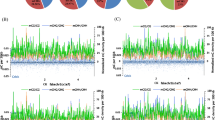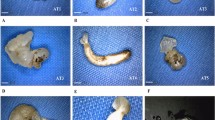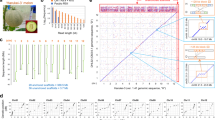Abstract
Ripening of tomato fruits is triggered by the plant hormone ethylene, but its effect is restricted by an unknown developmental cue to mature fruits containing viable seeds. To determine whether this cue involves epigenetic remodeling, we expose tomatoes to the methyltransferase inhibitor 5-azacytidine and find that they ripen prematurely. We performed whole-genome bisulfite sequencing on fruit in four stages of development, from immature to ripe. We identified 52,095 differentially methylated regions (representing 1% of the genome) in the 90% of the genome covered by our analysis. Furthermore, binding sites for RIN, one of the main ripening transcription factors, are frequently localized in the demethylated regions of the promoters of numerous ripening genes, and binding occurs in concert with demethylation. Our data show that the epigenome is not static during development and may have been selected to ensure the fidelity of developmental processes such as ripening. Crop-improvement strategies could benefit by taking into account not only DNA sequence variation among plant lines, but also the information encoded in the epigenome.
This is a preview of subscription content, access via your institution
Access options
Subscribe to this journal
Receive 12 print issues and online access
$209.00 per year
only $17.42 per issue
Buy this article
- Purchase on Springer Link
- Instant access to full article PDF
Prices may be subject to local taxes which are calculated during checkout





Similar content being viewed by others
References
Patterson, G.I., Thorpe, C.J. & Chandler, V.L. Paramutation, an allelic interaction, is associated with a stable and heritable reduction of transcription of the maize b regulatory gene. Genetics 135, 881–894 (1993).
Cubas, P., Vincent, C. & Coen, E. An epigenetic mutation responsible for natural variation in floral symmetry. Nature 401, 157–161 (1999).
Manning, K. et al. A naturally occurring epigenetic mutation in a gene encoding an SBP-box transcription factor inhibits tomato fruit ripening. Nat. Genet. 38, 948–952 (2006).
Law, J.A. & Jacobsen, S.E. Establishing, maintaining and modifying DNA methylation patterns in plants and animals. Nat. Rev. Genet. 11, 204–220 (2010).
Becker, C. et al. Spontaneous epigenetic variation in the Arabidopsis thaliana methylome. Nature 480, 245–249 (2011).
Schmitz, R.J. et al. Transgenerational epigenetic instability is a source of novel methylation variants. Science 334, 369–373 (2011).
Cokus, S.J. et al. Shotgun bisulphite sequencing of the Arabidopsis genome reveals DNA methylation patterning. Nature 452, 215–219 (2008).
Lister, R. et al. Highly integrated single-base resolution maps of the epigenome in Arabidopsis. Cell 133, 523–536 (2008).
Zemach, A. et al. Local DNA hypomethylation activates genes in rice endosperm. Proc. Natl. Acad. Sci. USA 107, 18729–18734 (2010).
The Tomato Genome Consortium. The tomato genome sequence provides insights into fleshy fruit evolution. Nature 485, 635–641 (2012).
Klee, H.J. & Giovannoni, J.J. Genetics and control of tomato fruit ripening and quality attributes. Annu. Rev. Genet. 45, 41–59 (2011).
Burg, S.P. & Burg, E.A. Ethylene action and the ripening of fruits. Science 148, 1190–1196 (1965).
Hamilton, A.J., Lycett, G.W. & Grierson, D. Antisense gene that inhibits synthesis of the hormone ethylene in transgenic plants. Nature 346, 284–287 (1990).
Oeller, P.W., Lu, M.W., Taylor, L.P., Pike, D.A. & Theologis, A. Reversible inhibition of tomato fruit senescence by antisense RNA. Science 254, 437–439 (1991).
Seymour, G., Poole, M., Manning, K. & King, G.J. Genetics and epigenetics of fruit development and ripening. Curr. Opin. Plant Biol. 11, 58–63 (2008).
Messeguer, R., Ganal, M.W., Steffens, J.C. & Tanksley, S.D. Characterization of the level, target sites and inheritance of cytosine methylation in tomato nuclear DNA. Plant Mol. Biol. 16, 753–770 (1991).
Vrebalov, J. et al. A MADS-box gene necessary for fruit ripening at the tomato ripening-inhibitor (Rin) locus. Science 296, 343–346 (2002).
Martel, C., Vrebalov, J., Tafelmeyer, P. & Giovannoni, J.J. The tomato MADS-box transcription factor ripening inhibitor interacts with promoters involved in numerous ripening processes in a colorless nonripening–dependent manner. Plant Physiol. 157, 1568–1579 (2011).
Ito, Y. et al. DNA-binding specificity, transcriptional activation potential, and the rin mutation effect for the tomato fruit-ripening regulator RIN. Plant J. 55, 212–223 (2008).
Fujisawa, M., Nakano, T. & Ito, Y. Identification of potential target genes for the tomato fruit-ripening regulator RIN by chromatin immunoprecipitation. BMC Plant Biol. 11, 26 (2011).
Barry, C.S., Llop-Tous, M.I. & Grierson, D. The regulation of 1-aminocyclopropane-1-carboxylic acid synthase gene expression during the transition from system-1 to system-2 ethylene synthesis in tomato. Plant Physiol. 123, 979–986 (2000).
Lister, R. et al. Human DNA methylomes at base resolution show widespread epigenomic differences. Nature 462, 315–322 (2009).
Feng, S., Jacobsen, S.E. & Reik, W. Epigenetic reprogramming in plant and animal development. Science 330, 622–627 (2010).
Deikman, J., Kline, R. & Fischer, R.L. Organization of ripening and ethylene regulatory regions in a fruit-specific promoter from tomato (Lycopersicon esculentum). Plant Physiol. 100, 2013–2017 (1992).
Nicholass, F.J., Smith, C.J., Schuch, W., Bird, C.R. & Grierson, D. High levels of ripening-specific reporter gene expression directed by tomato fruit polygalacturonase gene-flanking regions. Plant Mol. Biol. 28, 423–435 (1995).
McMurchie, E.J., McGlasson, W.B. & Eaks, I.L. Treatment of fruit with propylene gives information about the biogenesis of ethylene. Nature 237, 235–236 (1972).
King, G.N. Artificial parthenocarpy in Lycopersicum esculentum; tissue development. Plant Physiol. 22, 572–581 (1947).
Wang, H. et al. Regulatory features underlying pollination-dependent and -independent tomato fruit set revealed by transcript and primary metabolite profiling. Plant Cell 21, 1428–1452 (2009).
Thurman, R.E. et al. The accessible chromatin landscape of the human genome. Nature 489, 75–82 (2012).
Stadler, M.B. et al. DNA-binding factors shape the mouse methylome at distal regulatory regions. Nature 480, 490–495 (2011).
Zhong, S. et al. High-throughput illumina strand-specific RNA sequencing library preparation. Cold Spring Harb. Protoc. 2011, 940–949 (2011).
Chen, Y.R. et al. A cost-effective method for Illumina small RNA-Seq library preparation using T4 RNA ligase 1 adenylated adapters. Plant Methods 8, 41 (2012).
Ricardi, M.M., Gonzalez, R.M. & Iusem, N.D. Protocol: fine-tuning of a chromatin immunoprecipitation (ChIP) protocol in tomato. Plant Methods 6, 11 (2010).
Langmead, B., Trapnell, C., Pop, M. & Salzberg, S.L. Ultrafast and memory-efficient alignment of short DNA sequences to the human genome. Genome Biol. 10, R25 (2009).
Trapnell, C., Pachter, L. & Salzberg, S.L. TopHat: discovering splice junctions with RNA-Seq. Bioinformatics 25, 1105–1111 (2009).
Wang, L.K., Feng, Z.X., Wang, X., Wang, X.W. & Zhang, X.G. DEGseq: an R package for identifying differentially expressed genes from RNA-seq data. Bioinformatics 26, 136–138 (2010).
Smyth, G.K. Linear models and empirical bayes methods for assessing differential expression in microarray experiments. Stat. Appl. Genet. Mol. Biol. 3, 3 (2004).
Benjamini, Y. & Hochberg, Y. Controlling the false discovery rate—a practical and powerful approach to multiple testing. J. R. Stat. Soc., B 57, 289–300 (1995).
Zhang, Y. et al. Model-based analysis of ChIP-Seq (MACS). Genome Biol. 9, R137 (2008).
Acknowledgements
We thank E. Richards, R. Schmitz and J. Ecker for discussion and thoughtful advice in preparing this manuscript, and R. White, Y. Xu and Z. Li for technical assistance. This project was supported by the United States Department of Agriculture – Agricultural Research Service, National Science Foundation IOS-0606595 and IOS-0923312 to J.J.G. and Z.F., DBI-0820612 to J.J.G., National Natural Science Foundation of China 30900783 and 3090243 to S.Z. and B.L. and the Human Frontier Science Program LTF000076/2009 to S.Z.
Author information
Authors and Affiliations
Contributions
J.J.G., Z.F. and S.Z. devised the project and wrote the manuscript. Z.F. and S.Z. led the bioinformatic and experimental teams, respectively. Y.-R.C., J.V., R.M. and N.G. performed the experiments. Y.Z., Z.F., M.H., B.L., Y.S., J.X. and J.J.G. analyzed and interpreted the data.
Corresponding authors
Ethics declarations
Competing interests
The authors declare no competing financial interests.
Supplementary information
Supplementary Text and Figures
Supplementary Figures 1–11 (PDF 2185 kb)
Supplementary Tables
Supplementary Tables 1–12 (XLSX 4924 kb)
Rights and permissions
About this article
Cite this article
Zhong, S., Fei, Z., Chen, YR. et al. Single-base resolution methylomes of tomato fruit development reveal epigenome modifications associated with ripening. Nat Biotechnol 31, 154–159 (2013). https://doi.org/10.1038/nbt.2462
Received:
Accepted:
Published:
Issue Date:
DOI: https://doi.org/10.1038/nbt.2462
This article is cited by
-
Epigenetics: Toward improving crop disease resistance and agronomic characteristics
Plant Biotechnology Reports (2024)
-
Regulation of phenylpropanoid biosynthesis in strawberry ripening: molecular and hormonal mechanisms
Phytochemistry Reviews (2024)
-
Transcriptional and epigenetic changes during tomato yellow leaf curl virus infection in tomato
BMC Plant Biology (2023)
-
Understanding the mechanism of red light-induced melatonin biosynthesis facilitates the engineering of melatonin-enriched tomatoes
Nature Communications (2023)
-
The allotetraploid horseradish genome provides insights into subgenome diversification and formation of critical traits
Nature Communications (2023)



